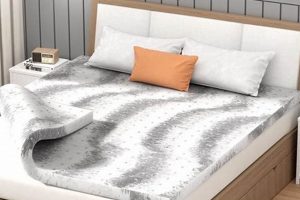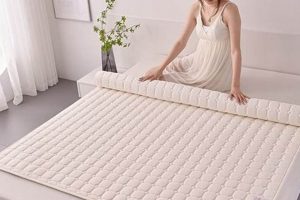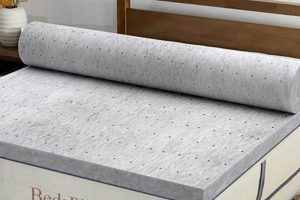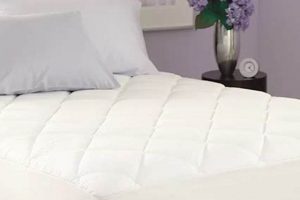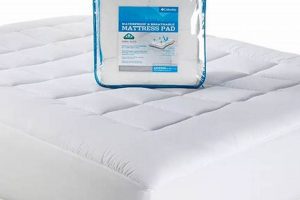A protective layer designed to shield a sleeping surface from nocturnal enuresis is commonly employed. This layer typically consists of absorbent and waterproof materials, preventing urine from penetrating the underlying mattress. For example, a quilted, vinyl-backed covering placed atop the bed provides a barrier against moisture damage.
The utilization of these protective products offers several key advantages. It preserves the lifespan and hygiene of the mattress, thereby reducing the frequency and cost of replacement. Historically, such protection consisted of makeshift solutions; however, modern advancements in textile technology have yielded highly effective and easily maintained options. This contributes to improved sleep hygiene and overall well-being.
The following sections will delve into the various types available, their respective features and benefits, considerations for selecting the most suitable option, proper care and maintenance, and the impact on managing childhood or adult nocturnal enuresis.
Protective Layer Best Practices
Optimal utilization of specialized bedding accessories designed for managing nocturnal enuresis necessitates adherence to specific guidelines to maximize effectiveness and longevity.
Tip 1: Selection Based on Absorbency Needs: Assess the anticipated volume of urine output. Opt for materials with higher absorbency ratings for individuals experiencing frequent or heavy bedwetting episodes. For lighter cases, thinner, less absorbent options may suffice.
Tip 2: Prioritize Waterproof Integrity: Confirm the waterproof backing is impermeable. Vinyl or polyurethane backings are common and effective. Regularly inspect for any signs of wear or delamination that could compromise the barrier.
Tip 3: Ensure Proper Fit: Select a product that adequately covers the entire mattress surface. Oversized variants offer increased protection against leakage, while properly fitted options prevent bunching and discomfort during sleep.
Tip 4: Regular Cleaning and Sanitization: Follow manufacturer instructions for laundering. Frequent washing helps remove urine residue and prevents odor buildup. Consider using a mild detergent and avoiding harsh chemicals that could degrade the waterproof layer.
Tip 5: Consider Layered Protection: Employing multiple layers, such as absorbent pads beneath the primary barrier, can further enhance protection and simplify cleanup after an incident.
Tip 6: Addressing Underlying Causes: Consider professional medical advice to treat bedwetting. The right mattress cover is helpful, but might not be the primary fix.
Tip 7: Monitor product’s condition: Consistently check your mattress pad for rips, tears or any signs of wear and tear. If the quality has degraded, buy a new one.
Adherence to these guidelines will contribute to a more sanitary sleeping environment, extend the lifespan of the mattress, and provide increased peace of mind for individuals managing nocturnal enuresis.
The concluding section will summarize the main advantages of using protective bedding and offer final recommendations for effective bedwetting management.
1. Absorbency
Absorbency is a critical performance characteristic when evaluating bedding protection designed for nocturnal enuresis. The capacity of a material to retain fluid directly dictates its effectiveness in preventing mattress contamination and subsequent damage.
- Material Composition and Absorption Rate
The inherent properties of the constituent materials significantly influence absorbency rates. Fabrics such as cotton and bamboo rayon exhibit natural fluid retention capabilities. Superabsorbent polymers (SAPs), often incorporated into the inner layers, dramatically increase the overall capacity to manage fluid volume. The absorption rate, or the speed at which a material can draw in liquid, is also vital. Faster absorption minimizes surface pooling and potential leakage.
- Layered Construction and Fluid Distribution
Multi-layered constructions optimize fluid management. A top layer facilitates rapid fluid intake, channeling it towards more absorbent inner layers. This distribution mechanism prevents saturation of any single area, maximizing the overall capacity of the bedding accessory. Some designs incorporate channels or quilting to promote even fluid dispersion.
- Testing and Absorbency Ratings
Standardized testing methods quantify the absorbency performance of these products. Ratings, often expressed in milliliters or ounces, provide a comparative metric for consumers. These ratings should be considered in conjunction with the frequency and volume of nocturnal enuresis when selecting a suitable protective layer. Higher ratings indicate a greater capacity to handle larger incidents.
- Impact on Comfort and Hygiene
The absorbency level affects user comfort. Overly saturated materials can lead to dampness and discomfort during sleep. Effective fluid retention reduces the duration of skin contact with urine, minimizing the risk of irritation and odor development. Quick-drying properties further enhance comfort and hygiene.
In conclusion, absorbency is a key determinant of a “mattress pad for bedwetting”‘s functionality. Careful consideration of material composition, construction, testing data, and comfort implications is essential for selecting a product that effectively mitigates the adverse effects of nocturnal enuresis.
2. Waterproof Barrier
A critical element in the functionality of a “mattress pad for bedwetting” lies in its waterproof barrier. This component provides the primary defense against fluid penetration, directly influencing the product’s ability to protect the underlying mattress from damage and maintain a hygienic sleeping environment.
- Material Composition and Waterproofing Mechanism
The effectiveness of a waterproof barrier is intrinsically linked to its material composition. Common materials include polyurethane films, vinyl coatings, and specialized laminated fabrics. These materials create an impermeable layer that prevents liquids from seeping through. The mechanism often involves a tightly woven structure or a non-porous membrane that blocks fluid passage at a microscopic level. Examples include thermoplastic polyurethane (TPU) films, known for their flexibility and waterproof properties, and polyvinyl chloride (PVC), which provides a more rigid barrier.
- Breathability Considerations
While impermeability is essential, breathability is also a significant factor affecting user comfort. A completely non-breathable barrier can trap moisture and heat, leading to discomfort and potential skin irritation. Some advanced waterproof mat
erials incorporate microporous structures that allow air to circulate while preventing liquid penetration. This balance between waterproofing and breathability is a key consideration in product design. - Durability and Resistance to Wear
The long-term effectiveness of a waterproof barrier depends on its durability and resistance to wear. Repeated washing, abrasion from bedding, and exposure to body heat can degrade the barrier over time. Reinforced seams and durable materials, such as tightly woven polyester with a waterproof coating, can enhance the product’s lifespan. Regular inspection for cracks, tears, or delamination is crucial to ensure continued protection.
- Testing and Performance Standards
Rigorous testing ensures the waterproof barrier meets established performance standards. Hydrostatic pressure tests, for example, measure the amount of water pressure the material can withstand before leakage occurs. Abrasion resistance tests evaluate the material’s ability to withstand wear and tear. Compliance with these standards provides consumers with assurance regarding the product’s quality and reliability.
In summary, the waterproof barrier is an indispensable component of any “mattress pad for bedwetting.” Selection of appropriate materials, consideration of breathability, focus on durability, and adherence to performance standards are essential factors in ensuring effective and long-lasting mattress protection.
3. Material Composition
The selection of materials significantly impacts the functionality and effectiveness of a mattress pad designed for bedwetting. Material composition influences key characteristics, including absorbency, waterproofing, breathability, durability, and ease of maintenance. Ineffective material choices can lead to inadequate protection, discomfort, and a reduced lifespan for both the pad and the mattress it is intended to safeguard. For instance, a pad relying solely on a thin cotton layer for absorbency may quickly saturate, failing to prevent urine from reaching the mattress. Similarly, a waterproof layer constructed from low-grade vinyl may crack or delaminate prematurely, compromising its protective function. This directly highlights the cause-and-effect relationship between material choice and product performance.
Different material combinations offer distinct advantages. A common and effective design incorporates a top layer of quilted cotton or bamboo rayon for comfort and initial absorption, followed by an inner layer of super-absorbent polymer (SAP) for retaining significant fluid volumes. A waterproof backing, typically made of polyurethane or a similar impermeable material, completes the assembly. This layered approach optimizes fluid management. The practical significance of understanding material composition is evident in the decision-making process. Knowledgeable consumers can assess product specifications, compare material properties, and select a mattress pad tailored to their specific needs and circumstances. For example, individuals with sensitive skin may prioritize hypoallergenic materials like organic cotton or Tencel, while those seeking maximum protection may opt for pads with thicker SAP layers and reinforced waterproof barriers.
In conclusion, material composition is not merely a technical detail but a fundamental determinant of a mattress pad’s ability to protect against bedwetting. Understanding the properties and performance characteristics of various materials empowers consumers to make informed choices, maximizing the value and effectiveness of their purchase. This comprehension helps to overcome the challenge of selecting from the numerous options available and ensures the chosen pad provides reliable, comfortable, and hygienic protection for the mattress.
4. Size and Fit
The dimensions and secure placement of protective bedding significantly affect its effectiveness in managing nocturnal enuresis. Inadequate size or improper fit can compromise the protective barrier, leading to mattress contamination. A protective pad that is too small will leave portions of the mattress exposed, rendering it vulnerable to urine saturation. Similarly, a pad that shifts or bunches due to poor fit creates gaps through which fluids can seep. For example, a twin-size pad placed on a full-size mattress offers incomplete coverage, negating its intended purpose. Conversely, a pad that is excessively large may be difficult to manage and secure, increasing the likelihood of displacement during sleep.
Correct size and fit ensure complete mattress coverage and prevent shifting during use. Fitted options, similar to fitted sheets, offer enhanced security by anchoring to the mattress corners. Overhang is sufficient to tuck securely, further minimizing movement. The practical implications of appropriate size and fit extend to hygiene and maintenance. A properly fitted pad is easier to remove and launder, preventing prolonged exposure to urine and minimizing odor accumulation. Consistent use of an appropriately sized and fitted product contributes to preserving the mattress’s integrity, extending its lifespan, and maintaining a cleaner sleep environment. If it is not easy to pull out the pad, it is a sign the product is not the correct size.
In conclusion, the selection of a “mattress pad for bedwetting” requires careful consideration of mattress dimensions to ensure complete coverage and secure placement. Proper size and fit are not merely aesthetic concerns but fundamental factors that determine the product’s ability to protect the mattress, maintain hygiene, and promote a comfortable and sanitary sleep environment. Purchasing mattress protectors, while useful, might not be the primary fix and medical consultation is recommended.
5. Maintenance
The longevity and effectiveness of a protective layer designed for managing nocturnal enuresis are intrinsically linked to appropriate care procedures. Inadequate cleaning or improper handling diminishes the product’s ability to safeguard the underlying mattress, leading to accelerated degradation and potential hygienic concerns. For instance, infrequent washing allows urine residue to accumulate, fostering bacterial growth and unpleasant odors, thereby compromising the sleep environment. Similarly, using harsh chemicals during laundering can damage the waterproof barrier or absorbent materials, rendering the pad ineffective. Neglecting to follow manufacturer instructions causes damage that is hard to restore.
Proper maintenance protocols, conversely, preserve the product’s functional properties and extend its lifespan. Regular washing, in accordance with care label guidelines, removes urine, prevents odor buildup, and inhibits bacterial proliferation. Utilizing mild detergents avoids damage to the waterproof layer and absorbent fibers. Promptly addressing stains and spills prevents them from setting and becoming more difficult to remove. Drying the pad thoroughly after washing minimizes the risk of mildew growth. Rotation of multiple pads ensures even wear and allows for thorough cleaning between uses. One key to keep in mind is that mattress protection is not the only consideration, one should consult medical experts.
In conclusion, consistent and conscientious
maintenance is not merely an ancillary task but a crucial determinant of a protective bedding’s long-term performance and value. Adhering to recommended cleaning and care procedures ensures the ongoing effectiveness of the waterproof barrier, preserves the absorbent properties, and promotes a hygienic sleep environment, thereby safeguarding the mattress and contributing to overall well-being. By prioritizing maintenance, the end product of the pads are ensured of quality.
6. Durability
The lifespan of a protective bedding solution directly impacts its cost-effectiveness and overall value. The ability to withstand repeated use, laundering cycles, and potential exposure to corrosive fluids determines its long-term suitability. Insufficient resistance to wear and tear results in premature degradation, necessitating frequent replacement and negating initial cost savings. For example, a pad constructed with weak seams or a fragile waterproof membrane may tear or delaminate after only a few washes, requiring replacement within a short timeframe. The relationship between material quality, construction techniques, and product longevity is therefore fundamental. Better the product is built, more the customers are satisfied.
Durability manifests in several key attributes, including resistance to abrasion, tearing, and chemical degradation. High-quality materials, such as tightly woven fabrics and reinforced waterproof layers, enhance resistance to physical stress during washing and use. Robust seam construction prevents unraveling and tearing, while resistance to chemicals ensures the integrity of the waterproof barrier upon exposure to urine and cleaning agents. A practical illustration is the difference between a pad with a thin, unbacked vinyl layer, which may crack and peel easily, and one with a multi-layered polyurethane laminate, which offers superior resistance to degradation. As such, choosing the right material would be more useful for the pad’s durability.
In summary, durability is not merely a desirable characteristic but a critical performance factor in the context of bedding designed for managing bedwetting. Prioritizing products constructed with durable materials, employing robust construction techniques, and demonstrating resistance to chemical degradation ensures long-term protection, minimizes replacement costs, and promotes a consistently hygienic sleeping environment. Therefore, the best way is to find better durability and high quality pads for your use.
Frequently Asked Questions
This section addresses common inquiries and misconceptions regarding the use of protective mattress coverings for nocturnal enuresis management.
Question 1: What materials are most effective in a mattress pad for preventing urine penetration?
Polyurethane films and tightly woven, coated fabrics provide superior waterproof barriers compared to thinner, less robust materials like vinyl. The density and integrity of the barrier are key determinants of effectiveness.
Question 2: How frequently should a mattress pad be laundered?
Laundering frequency depends on usage and the severity of bedwetting incidents. However, washing after each incident is advisable. Regular washing, even without visible soiling, helps maintain hygiene and prevent odor buildup.
Question 3: Are all mattress pads for bedwetting hypoallergenic?
Not all protective pads are hypoallergenic. Individuals with sensitivities should select options made from hypoallergenic materials like organic cotton, bamboo rayon, or Tencel. Check product specifications carefully.
Question 4: Can a mattress pad completely eliminate the need for mattress cleaning?
While a high-quality mattress pad significantly reduces the risk of mattress contamination, it does not guarantee complete protection. Prompt attention to spills and periodic mattress cleaning remain advisable for optimal hygiene.
Question 5: What is the expected lifespan of a mattress pad designed for bedwetting?
Lifespan varies depending on material quality, usage frequency, and care practices. Durable options, properly maintained, can last several years. However, regular inspection for wear and tear is essential, and replacement is necessary when the waterproof barrier is compromised.
Question 6: How does the thickness of a mattress pad affect its performance?
Thickness does not always correlate directly with performance. While thicker pads may offer greater absorbency, the quality of the materials and the effectiveness of the waterproof barrier are more critical factors. A thin pad constructed with high-quality, absorbent materials and a reliable waterproof layer can outperform a thicker pad made with inferior components.
The proper selection and maintenance of a “mattress pad for bedwetting” are crucial for effectively managing nocturnal enuresis and protecting the underlying mattress. Diligent adherence to care instructions and consideration of individual needs are essential for optimal results.
The concluding section offers a summary of key considerations and final recommendations.
Conclusion
The preceding discussion has comprehensively explored the multifaceted aspects of “mattress pad for bedwetting.” This protective bedding plays a critical role in mitigating the detrimental effects of nocturnal enuresis, safeguarding mattresses from urine damage, and promoting a sanitary sleeping environment. Effective implementation necessitates a thorough understanding of material properties, construction techniques, maintenance protocols, and appropriate size and fit considerations. Neglecting these factors can compromise the product’s performance, leading to reduced lifespan, hygiene concerns, and inadequate protection.
Given the significant impact of nocturnal enuresis on individuals and families, informed decision-making in the selection and utilization of “mattress pad for bedwetting” is paramount. Prioritizing quality materials, proper maintenance, and adherence to recommended guidelines ensures long-term protection and contributes to improved sleep hygiene. Continuous research and development in textile technology promise further advancements in protective bedding, offering enhanced performance and comfort for those managing bedwetting.


